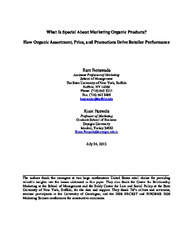What is special about marketing organic products? How organic assortment, price, and promotions drive retailer performance
| dc.contributor.author | Bezawada, R. | |
| dc.contributor.author | Pauwels, Koen Hendrik | |
| dc.date.accessioned | 2014-06-18T13:11:29Z | |
| dc.date.available | 2014-06-18T13:11:29Z | |
| dc.date.issued | 2013-01 | |
| dc.identifier.issn | 1547-7185 | |
| dc.identifier.uri | http://hdl.handle.net/10679/371 | |
| dc.identifier.uri | http://journals.ama.org/doi/abs/10.1509/jm.10.0229?journalCode=jmkg | |
| dc.description.abstract | Higher sales and margins are key goals for retailers promoting emerging products, such as organics, but little is known about their marketing effectiveness and their cross-effects on conventional product sales. Extant research reports conflicting results about price and promotional sensitivity for organic products and does not address the impact of organic assortment. This article calculates long-term own- and cross-elasticities of organic and conventional product sales in response to changes in assortment, price, and promotions. Using a rich data set of 56 categories, the authors test hypotheses on how different costs and benefits of organic products affect these elasticities. They find that enduring actions, such as assortment and regular price changes, have a higher elasticity for organics than for conventional products. In contrast with common wisdom, even “core” organic consumers are sensitive to these actions. Increasing organic assortment and promotion breadth yields higher profits for the total category, as do more frequent promotions on conventional products. Our category comparison yields specific advice as to where larger assortment, lower prices versus more and deeper promotions are most effective. | en_US |
| dc.description.sponsorship | Center for Relationship Marketing at the School of Management ; Baldy Center for Law and Social Policy at the State University of New York | |
| dc.language.iso | eng | en_US |
| dc.publisher | American Marketing Association | en_US |
| dc.relation.ispartof | Journal of Marketing | |
| dc.rights | openAccess | |
| dc.title | What is special about marketing organic products? How organic assortment, price, and promotions drive retailer performance | en_US |
| dc.type | Article | en_US |
| dc.description.version | pre-print | |
| dc.peerreviewed | yes | en_US |
| dc.publicationstatus | published | en_US |
| dc.contributor.department | Özyeğin University | |
| dc.contributor.authorID | (ORCID & YÖK ID 141722) Pauwels, Koen | |
| dc.contributor.ozuauthor | Pauwels, Koen Hendrik | |
| dc.identifier.volume | 77 | |
| dc.identifier.issue | 1 | |
| dc.identifier.startpage | 31 | |
| dc.identifier.endpage | 51 | |
| dc.identifier.wos | WOS:000312685900003 | |
| dc.identifier.doi | 10.1509/jm.10.0229 | |
| dc.subject.keywords | Organic products | en_US |
| dc.subject.keywords | Food marketing | en_US |
| dc.subject.keywords | Empirical generalizations | en_US |
| dc.subject.keywords | Cross-category | en_US |
| dc.subject.keywords | Assortment | en_US |
| dc.subject.keywords | Marketing mix | en_US |
| dc.subject.keywords | Vector autoregressive models | en_US |
| dc.identifier.scopus | SCOPUS:2-s2.0-84873283105 | |
| dc.contributor.authorMale | 1 |
Files in this item
This item appears in the following Collection(s)
Share this page



